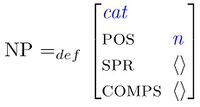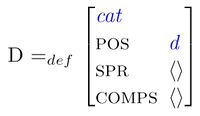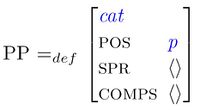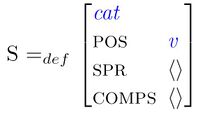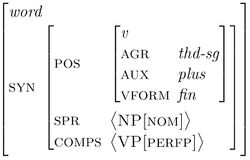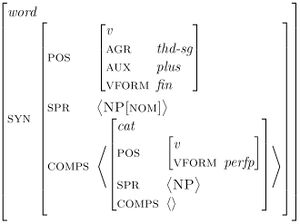Syntax 1 Wiki: Week 6: Difference between revisions
| Line 129: | Line 129: | ||
== Polar interrogatives (= Yes-no questions) == | == Polar interrogatives (= Yes-no questions) == | ||
Recall that one position where English requires an auxiliary and bans main verbs is the first position in yes-no questions: | Recall that one position where English requires an auxiliary and bans main verbs is the first position in yes-no questions: | ||
(1) Has Lilly spoken to Fido? | |||
(2) *Spoke Lilly to Fido? | |||
Let us now capture this generalization with our grammar. We begin by recalling the lexical entry of the auxiliary ''has'': | |||
Revision as of 10:10, 30 November 2020
Abbreviations
To make life easier on us, we use a number of abbreviations in valence lists, e.g. NP, PP, etc. In the next exercise you are supposed to find out which feature structures each of these abbreviations stand for. To this end, do the following exercises.
- Go to the online grammar.
- Click on the lexical entry for amuse.
- Click on the tree.
- There are two NP-nodes in the verb's valence lists.
- Open both of them and find what the two feature structures have in common. That is what the symbol "NP" abbreviates.
Exercises
(1) Which feature structure does the symbol "NP" stand for?
Now follow the same procedure for the abbreviatory symbols below.
(2) Which feature structure does the symbol "D" stand for?
(3) Which feature structure does the symbol "PP" stand for?
(4) Which feature structure does the symbol "VP" stand for?
(5) Which feature structure does the symbol "S" stand for?
Auxiliaries
Through the feature AUX, we can distinguish auxiliaries from main verbs. This is necessary because in English auxiliaries have a number of syntactic properties that sets them sharply apart from main verbs.
Illustration:
1. Auxiliaries, but not main verbs, can appear before the negation:
- Lilly has not spoken to Fido.
- *Lilly spoke not to Fido.
2. Auxiliaries, but not main verbs, can appear before the subject in Yes-no questions:
- Has Lilly spoken to Fido?
- *Spoke Lilly to Fido?
The syntactic contexts where only auxiliaries can appear are therefore marked [AUX +].
Exercise
Using the abbreviations introduced in the last section, write a lexical entry for the auxiliary did as it is used in the following sentence:
Lilly has seen the movie.
Now let us be more precise and expand the symbol "VP" in the entry above. What will the result be?
The lexical entry of has with the symbol "VP" spelled out
- Go to the online grammar.
- Display the lexical entry of has and convince yourself that it is the same as above.
Exercise
- Write down by hand the lexical entry of the progressive auxiliary is.
- Now go to the online grammar.
- Display the lexical entry of is and check your answer.
Exercise
- Write down by hand the lexical entry of the progressive auxiliary will.
- Now go to the online grammar.
- Display the lexical entry of will and check your answer.
Exercise
- Go to the online grammar.
- Type in the sentences below one by one and predict what the result will be.
- Explain what the result is in each case.
- (1) Lilly has spoken to Fido.
- (2) Lilly has speak to Fido.
- (3) Lilly has speaking to Fido.
- (4) Lilly is spoken to Fido.
- (5) Lilly is speak to Fido.
- (6) Lilly is speaking to Fido.
- (7) Lilly will spoken to Fido.
- (8) Lilly will speak to Fido.
- (9) Lilly will speaking to Fido.
Polar interrogatives (= Yes-no questions)
Recall that one position where English requires an auxiliary and bans main verbs is the first position in yes-no questions:
(1) Has Lilly spoken to Fido? (2) *Spoke Lilly to Fido?
Let us now capture this generalization with our grammar. We begin by recalling the lexical entry of the auxiliary has:
Navigation:
